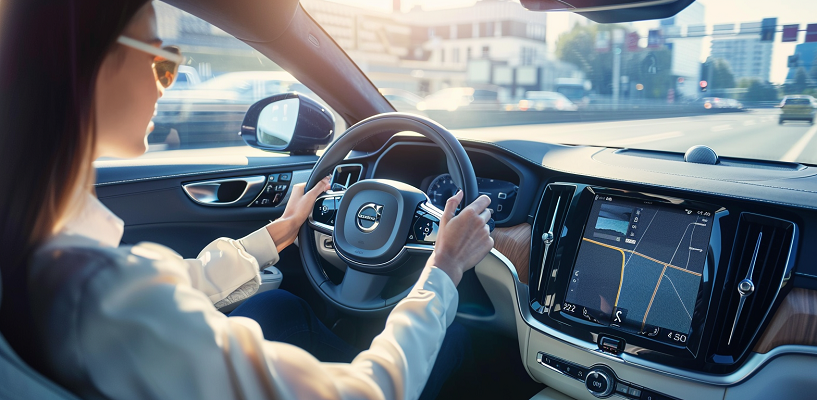- Home
- >>
- US
- >>
- Technology
- >>
- Automotive
- >>
- Hands On Driving
Hands On Driving

“Hands On Driving” Cars -
“Hands on Driving” Tesla -
“““The “hands on driving” features offered by Tesla are “Enhanced Autopilot”, “Basic Autopilot”, and “Full Self-Driving Capability”. An enhanced set of driver assistance functions is called Autopilot. “Autosteer” and “Traffic-Aware Cruise Control” are included with Basic Autopilot. “Auto Lane Change”, “Autopark”, “Navigate on Autopilot”, “Summon”, and “Smart Summon” are among the extra capabilities of Enhanced Autopilot. “Full Self-Driving Capability” comprises “Traffic Light & Stop Sign Control“.
The cameras on the “Model 3” are utilized by Autopilot to keep an eye on the surroundings and identify objects like curbs and barriers as well as other cars, pedestrians, and road markings.
A sequence of intensifying alerts advising you to maintain “your hands on the wheel” and “remain alert to the road” are displayed by the “Model 3” when Autopilot is on. If there is no action/response, Autopilot disconnects and is unavailable for the remainder of the drive.
Autopilot is not a “collision warning” or “avoidance” technology; rather, it is made for your ease and convenience when driving. Always keep an eye on the road ahead of you, and always be ready to make a correction. If you don’t, you risk death or severe damage.
The driver-assist technologies of Autopilot (including Traffic-Aware Cruise Control and Autosteer) are SAE Level 2 systems. 90 mph is the highest speed at which Autosteer can work. Learn more about SAE levels.
Only Tesla cars manufactured after September 2014 is compatible with autopilot, and its features have evolved over time. As of mid-February 2022, Tesla Vision—which uses advanced neural net processing to provide Autopilot features—will be standard on all vehicles built for the North American market””” — as stated at “tesla.com/support/autopilot”.
Autopilot automatically modifies the set cruising speed to the highway speed limit plus whatever offset you specify when you enter an on-ramp leading to a controlled-access roadway.
“Hands on Driving” Nissan -
“““Nissan offers a “hands on driving” assistance technology called “ProPILOT Assist”. ProPILOT Assist has a stop and hold feature along with Nissan’s “Intelligent Cruise Control” and “Steering Assist” technology. With the aid of “ProPILOT Assist”, you may stay in your lane and maintain a predetermined gap from the car in front of you.
“ProPILOT Assist” is available in the following Nissan models as of March 2024: ARIYA, 2024 PATHFINDER, 2024 ROGUE, 2024 LEAF, and 2024 ALTIMA. “ProPILOT Assist” is a semi-autonomous SAE Level 2 system.
Collisions cannot be avoided with “ProPILOT Assist”. Always keep both hands on the wheel while keeping an eye on the traffic situation. “ProPILOT Assist” provides assistance to the driver up to a vehicle speed of 90 mph.
“Hands free single-lane driving” is accessible with “ProPILOT Assist 2.0” (available on Nissan ARIYA). When navigating in a single lane on a motorway, “ProPILOT Assist 2.0” enable drivers to take their feet off the pedals and hands off the wheel, by taking charge of “steering, accelerating and braking”. The 2.0 system offers limited supervision, thus in order to keep everyone safe, the driver may need to steer, brake, or accelerate at any time””” — according to information found at “nissanusa.com/experience-nissan/news-and-events/nissan-propilot-assist.html”.
“Hands on Driving” Kia -
Kia’s “hands on driving” technology is called “Highway Driving Assist”. “Highway Driving Assist” is not a full autonomous driving system; rather, it is an additional feature that helps the driver operate the car. Always be aware of the circumstances of the road, keep your eyes on the road, and “take the appropriate steps to drive safely, if necessary”.
“““Highway Driving Assist will interpret lane markings using Kia’s radar and LiDAR systems, enabling the vehicle to stay in its lane and merge into others to pass or change lanes.
When entering or travelling on a “controlled access road” of certain highways, “Highway Driving Assist” will function provided that all of the following requirements are met: “Smart Cruise Control” and “Lane Following Assist” must both be operational. A “controlled access road” is one that has few entries and exits and permits continuous, fast traffic flow””” — as expressed at “kia.com/content/dam/kia2/in/en/content/ev6-manual/topics/chapter6_28.html”.
Not every traffic condition may be recognized by “Highway Driving Assist”. Unidentifiable items, structures, guardrails, bicycles, motorbikes, pedestrians, toll gates, and “other objects” that could collide with the car might go undetected.
“Hands on Driving” Volkswagen -
Volkswagen’s “Travel Assist” feature uses a combination of “Lane Assist” and “Adaptive Cruise Control” features to assist you keep your car in its lane. When engaged, it provides assistance in acceleration, braking, and steering to the driver. “Travel Assist” intended to keep you from getting tired on lengthy road trips.
“Travel Assist” is now a standard feature on all automatic vehicles starting with the 2024 model year. The feature suite of IQ.DRIVE includes “Travel Assist”. “Travel Assist” is a partially automated “hands on driving” capability that is part of SAE Level 2.
“““In order to initiate the “Travel Assist”, your speed must be higher than the minimum and “lower than maximum”. The minimum speed for certain models is 15 mph, whereas it is 20 mph for others. The maximum speed is approximately 95 mph.
Bear both hands on the steering wheel when using “Travel Assist”, and bear in mind that the system is only able to identify vehicles travelling in the same direction and respond to items that are in the sensor’s field of vision. When a car approaches or intersects it, it does not respond””” — according to information found on “vw.com/en/iq-drive/travel-assist.html”.
The “Travel Assist” system may malfunction or cause unintentional braking if the sensors or sensor mounts become misaligned, break, or are obstructed by debris, ice, mud, or leaves.
“Hands on Driving” Volvo -
“““The “Pilot Assist” feature of Volvo is mainly meant to be used on major highways and other roads where it can contribute to a more enjoyable and stress-free driving experience. Only when the driver’s hands are on the steering wheel can “Pilot Assist” work.
Using the camera, “Pilot Assist” tracks the separation with “the car in front of yours” and the side markers of the traffic lane. “Pilot Assist” aims to place the car midway between the visible lane marking lines when it assists with steering. “Pilot Assist” steering aid can be changed at any moment by the driver, and it can also be pointed in a different direction.
“Pilot Assist” uses braking and acceleration to control speed. In circumstances where rapid braking is necessary, the driver must engage the brakes. For instance, if the car in front of you abruptly brakes. The camera and radar sensor have limits; thus, braking can happen suddenly or not at all.
When driving through bends, off-ramp, at a fork in the road, hauling a trailer, carrying a heavy load, etc., the driver should never wait for steering help from Pilot Assist””” — as mentioned at “volvocars.com/en-ca/support/car/xc90/article/468b6e20afa2c90ac0a8015164fa9740”.
2016 saw the debut of “Pilot Assist” on the Volvo XC90. The driver’s attention and discernment are not replaced by driver support features. “Pilot Assist” from Volvo is regarded as an SAE level 2 system.
Note: Terms “hands on driving” and “hands free driving” are different and used differently in terms of functionality of a vehicle. Some car brands provide “hands free driving” as an advancement to “hands on driving” — as discussed here. Thus, keep both of these technologies in mind.
That’s all friends.

